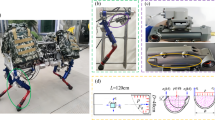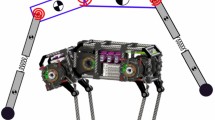Abstract
Galloping cheetahs, climbing mountain goats, and load hauling horses all show desirable locomotion capability, which motivates the development of quadruped robots. Among various quadruped robots, hydraulically driven quadruped robots show great potential in unstructured environments due to their discrete landing positions and large payloads. As the most critical movement unit of a quadruped robot, the limb leg unit (LLU) directly affects movement speed and reliability, and requires a compact and lightweight design. Inspired by the dexterous skeleton–muscle systems of cheetahs and humans, this paper proposes a highly integrated bionic actuator system for a better dynamic performance of an LLU. We propose that a cylinder barrel with multiple element interfaces and internal smooth channels is realized using metal additive manufacturing, and hybrid lattice structures are introduced into the lightweight design of the piston rod. In addition, additive manufacturing and topology optimization are incorporated to reduce the redundant material of the structural parts of the LLU. The mechanical properties of the actuator system are verified by numerical simulation and experiments, and the power density of the actuators is far greater than that of cheetah muscle. The mass of the optimized LLU is reduced by 24.5%, and the optimized LLU shows better response time performance when given a step signal, and presents a good trajectory tracking ability with the increase in motion frequency.
Graphic abstract















Similar content being viewed by others
References
Kashyap AK, Pandey A (2018) Different nature-inspired techniques applied for motion planning of wheeled robot: a critical review. Int J Adv Robot Autom 3(2):1–10
Lever JH, Denton D, Phetteplace GE et al (2006) Mobility of a lightweight tracked robot over deep snow. J Terramech 43(4):527–551. https://doi.org/10.1016/j.jterra.2005.09.002
Hildebrand M (1959) Motions of the running cheetah and horse. J Mammal 40(4):481–495. https://doi.org/10.2307/1376265
Park J, Kim KS, Kim S (2014) Design of a cat-inspired robotic leg for fast running. Adv Robot 28(23):1587–1598. https://doi.org/10.1080/01691864.2014.968617
Di Carlo J, Wensing PM, Katz B et al (2018) Dynamic locomotion in the MIT cheetah 3 through convex model-predictive control. In: 2018 IEEE/RSJ International Conference on Intelligent Robots and Systems, p.1–9 https://doi.org/10.1109/IROS.2018.8594448
Semini C, Tsagarakis NG, Guglielmino E et al (2010) Design and experimental evaluation of the hydraulically actuated prototype leg of the HyQ robot. In: 2010 IEEE/RSJ International Conference on Intelligent Robots and Systems, p.3640–3645. https://doi.org/10.1109/IROS.2010.5651548
Nelson G, Saunders A, Playter R (2019) The PETMAN and Atlas robots at Boston Dynamics. In: Goswami A, Vadakkepat P (Eds.), Humanoid Robotics: a Reference. Springer, Dordrecht, p.169–186. https://doi.org/10.1007/978-94-007-6046-2_15
Zhang K, Zhang JH, Gan MY et al (2022) Modeling and parameter sensitivity analysis of valve-controlled helical hydraulic rotary actuator system. Chin J Mech Eng 35(1):66. https://doi.org/10.1186/s10033-022-00737-w
Barasuol V, Villarreal-Magaña OA, Sangiah D et al (2018) Highly-integrated hydraulic smart actuators and smart manifolds for high-bandwidth force control. Front Robot AI 5:51. https://doi.org/10.3389/frobt.2018.00051
Kim JT, San Cho J, Park BY et al (2013) Experimental investigation on the design of leg for a hydraulic actuated quadruped robot. IEEE ISR 2013:1–5. https://doi.org/10.1109/ISR.2013.6695685
He J, Gao F (2020) Mechanism, actuation, perception, and control of highly dynamic multilegged robots: a review. Chin J Mech Eng 33(5):120–149. https://doi.org/10.1186/s10033-020-00485-9
Xu B, Zong HZ, Zhang JH et al (2022) Research status and development trend of carbon fiber reinforced polymer hydraulic cylinder. Acta Materiae Compositae Sinica 39(2):446–459 (in Chinese). https://doi.org/10.13801/j.cnki.fhclxb.20210824.002
Türk DA, Triebe L, Meboldt M (2016) Combining additive manufacturing with advanced composites for highly integrated robotic structures. Procedia CIRP 50:402–407. https://doi.org/10.1016/j.procir.2016.04.202
Gao J, Xiao M, Zhang Y et al (2020) A comprehensive review of isogeometric topology optimization: methods, applications and prospects. Chin J Mech Eng 33(1):87. https://doi.org/10.1186/s10033-020-00503-w
Shi G, Guan C, Quan D et al (2020) An aerospace bracket designed by thermo-elastic topology optimization and manufactured by additive manufacturing. Chin J Aeronaut 33(4):1252–1259. https://doi.org/10.1016/j.cja.2019.09.006
Yang JK, Gu DD, Lin KJ et al (2022) Laser additive manufacturing of bio-inspired metallic structures. Chin J Mech Eng Addit Manuf Front 1(1):100013. https://doi.org/10.1016/j.cjmeam.2022.100013
Huang H, Zhang JH, Xu B et al (2021) Topology optimization design of a lightweight integrated manifold with low pressure loss in a hydraulic quadruped robot actuator. Mech Sci 12(1):249–257. https://doi.org/10.5194/ms-12-249-2021
Wang JR, Xi YX, Ji C et al (2022) A biomimetic robot crawling bidirectionally with load inspired by rock-climbing fish. J Zhejiang Univ Sci A (Appl Phys & Eng) 23(1):14–26. https://doi.org/10.1631/jzus.A2100280
Bai XJ, Shang JZ, Luo ZR et al (2022) Development of amphibious biomimetic robots. J Zhejiang Univ Sci A (Appl Phys & Eng) 23(3):157–187. https://doi.org/10.1631/jzus.A2100137
Heglund NC, Taylor CR (1988) Speed, stride frequency and energy cost per stride: how do they change with body size and gait? J Exp Biol 138(1):301–318. https://doi.org/10.1242/jeb.138.1.301
Wang YJ, Liu CB, Ren LQ et al (2022) Bioinspired soft actuators with highly ordered skeletal muscle structures. Bio-Des Manuf 5(1):174–188. https://doi.org/10.1007/s42242-021-00148-1
Zhang JH, Huang H, Liu G et al (2021) Stiffness and energy absorption of additive manufactured hybrid lattice structures. Virtual Phys Prototyp 16(4):428–443. https://doi.org/10.1080/17452759.2021.1954405
Zhang M, Lin RC, Wang X et al (2020) 3D printing of Haversian bone–mimicking scaffolds for multicellular delivery in bone regeneration. Sci Adv 6(12):86725. https://doi.org/10.1126/sciadv.aaz6725
Bigham A, Foroughi F, Rezvani Ghomi E et al (2020) The journey of multifunctional bone scaffolds fabricated from traditional toward modern techniques. Bio-Des Manuf 3(4):281–306. https://doi.org/10.1007/s42242-020-00094-4
Zhang SS, Li HM, Huang YC (2021) An improved multi-objective topology optimization model based on SIMP method for continuum structures including self-weight. Struct Multidiscip Opt 63(1):211–230. https://doi.org/10.1007/s00158-020-02685-2
Acknowledgements
The work is supported by the National Natural Science Foundation of China (Nos. U21A20124 and 52205059) and the Key Research and Development Program of Zhejiang Province (No. 2022C01039).
Author information
Authors and Affiliations
Contributions
Conceptualization contributed by HZZ and JHZ; methodology contributed by HZZ, LJ, and KZ; resources contributed by HZZ, KW, and YLW; validation contributed by HZZ and ZYL; writing—original draft contributed by HZZ; writing—review and editing contributed by HZZ and JS; supervision contributed by JHZ; funding acquisition contributed by JHZ, ZYL, and BX. All authors have read and agreed to the published version of the manuscript.
Corresponding author
Ethics declarations
Conflict of interest
The authors declare that they have no conflict of interest.
Ethical approval
This study does not contain any studies with human or animal subjects performed by any of the authors.
Rights and permissions
Springer Nature or its licensor (e.g. a society or other partner) holds exclusive rights to this article under a publishing agreement with the author(s) or other rightsholder(s); author self-archiving of the accepted manuscript version of this article is solely governed by the terms of such publishing agreement and applicable law.
About this article
Cite this article
Zong, H., Zhang, J., Jiang, L. et al. Bionic lightweight design of limb leg units for hydraulic quadruped robots by additive manufacturing and topology optimization. Bio-des. Manuf. 7, 1–13 (2024). https://doi.org/10.1007/s42242-023-00256-0
Received:
Accepted:
Published:
Issue Date:
DOI: https://doi.org/10.1007/s42242-023-00256-0




